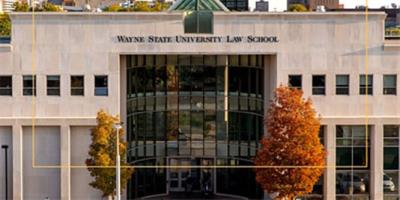
Established in 1927 as the Detroit City Law School, Wayne State University Law School is quickly approaching its 100th birthday. In advance of the centennial, Wayne State professor Alan Schenk has written a comprehensive history of the law school.
The longest serving faculty member in the school’s history, Schenk started teaching tax law at Wayne State in 1966 and continues to do so today as a distinguished professor of law and member of the university’s Academy of Scholars. He has served under every law school dean except one, and he has twice been an associate dean. Having personally witnessed much of that history unfold over the last 57 years, he is ideally positioned to write a definitive history of the law school. The book was five years in the making and is exceedingly well-researched, based upon an exhaustive examination of the school’s written records and nearly 100 interviews with a broad cross-section of graduates, deans, and professors.
Schenk’s book is a must read for any Wayne Law graduate. As he notes in the introduction, most law school histories discuss “the establishment of the school as independent or as part of a broader university institution, the leadership of the deans, the noted faculty, the influence of their scholarship, and how the school’s programs and reputation may have been influenced by the financial support it received from within the university and from its alumni and outside sources.” His book is unique in that it also focuses on the school’s students and alumni, many of whom, according to Schenk, have had “an outsized impact on the school’s development and reputation.”
Eugene Driker is undoubtedly one of the graduates who Schenk had in mind when he speaks of their outsized impact on the law school’s development and reputation. Like Richard Barber, James Robinson, Michael Terry, Hon. Nancy Garlock Edmunds, and Aleksandra Miziolek, Driker served as editor in chief of the Wayne aw Review but as Schenk correctly observes, his post-graduate contributions to the welfare of the university and reputation of its law school far exceeded his contributions as a student. Like fellow graduates Elizabeth Hardy and former Supreme Court Justice Marilyn Kelly, Driker served on the university’s board of governors and like alums Dan Gilbert, Alfred Taubman, Stephen Ross, and Carl Ziemba, Driker was also a very generous donor to the la w school, endowing the Driker Forum for Excellence in the Law among other contributions.
w school, endowing the Driker Forum for Excellence in the Law among other contributions.
Schenk is also high in his praise for Allan Campbell, a practicing attorney, adjunct professor at Detroit College of Law (now Michigan State University College of Law), and Wayne’s first dean. It was Campbell who successfully lobbied the Detroit Board of Education to establish a public law school in the city, focused on obtaining full ABA accreditation for the school, and encouraged applicants who had completed at least three years of undergraduate education — not universally required at the time — by promising them a bachelor’s degree after satisfactory completion of their first year of law school. Schenk proudly emphasizes the law school’s record of diversity, equity, and inclusion starting with its very first class, 10% of whom were women (that number would climb to 25% by 1930) and many of whom were Jewish or students of color, unlike the largely white, male, gentile classes at the time at DCL, the University of Detroit, and the University of Michigan. As has remained true throughout its history, a 1927 Wayne legal education was also a bargain in contrast to its competitors — tuition was $110 for Michigan residents ($150 for nonresidents) compared to $115 at DCL, $191 at the University of Detroit, and $118 ($109 for women) at the University of Michigan.
Campbell’s successor, Arthur Neef, the longest-serving dean in Wayne Law history, presided over a period of what Schenk calls “squandered opportunities.” Following a period of shrinkage due to the Great Depression and World War II, the law school tightened its admission standards yet increased its enrollment by more than sixfold as large numbers of returning veterans made use of their G.I. Bill benefits. Still, the school’s antiquated and overcrowded facilities forced it to turn away many qualified applicants; at the same time, it was largely staffed by faculty who had received their legal educations in the state of Michigan along with practicing lawyers and judges. In Schenk’s view, this period of retrenchment was the result of Neef’s inattention and his multiple university appointments which created an irreconcilable conflict of interest (which was exposed by a 1959 ABA reaccreditation report).
The 1960s ushered in a period of renaissance at the school. On Oct. 22, 1966, U.S. Supreme Court Chief Justice Earl Warren dedicated a new law school campus designed by Neef. In late 1967, Charles Joiner was appointed to replace Neef as law school dean as, according to Schenk’s telling, newly installed Wayne State President William Rea Keast finally heeded the pleas of faculty.
Schenk clearly views Joiner’s brief five-year deanship as transformative. He devotes an entire chapter to Joiner’s efforts to maintain a racially diverse faculty and student body, which included hosting one of the ABA Council on Legal Education Opportunity Institute programs in the summer of 1969, making overdue changes in academic rules to accommodate higher rates of retention, and hiring professor Edward J. Littlejohn to help recruit and retain students of color. Joiner transformed Wayne from a law school where most graduates “had to create their own opportunities by establishing their own practices or joining with classmates representing individuals and small businesses” to one whose graduates were not only welcomed but were sought after by the larger firms in Michigan, if not nationwide. According to Schenk, Joiner modernized the law school curriculum and transformed the faculty, doubling its size and hiring more teacher-scholars from across the country. Joiner also worked to reverse Wayne’s reputation in the academic community as a law school that routinely denied tenure to young, productive scholars and encouraged the faculty to take advantage of its urban location and become involved in the Detroit community.
Schenk devotes less ink to the nine Wayne State Law deans who followed Joiner, but he is high in his praise of the faculty, particularly skilled instructors like Janet Findlater, who was selected as Professor of the Year in 18 of her 40 years on the faculty, more times than any other professor. Noah Hall, Christopher Lund, William Ortman, and Eric Zacks are other multiple-year honorees. He recounts a “battle of the sexes” squash match between Findlater and revered professor Stephen Schulman staged by law students in the late 1970s following the epic tennis match between Billie Jean King and Bobby Riggs. Schulman’s love of scotch is also the subject of some humorous anecdotes.
In addition to Neef’s inattention during his tenure as dean, Schenk also touches on some, but not all, challenges faced by the law school. He discusses how Wayne navigated the nationwide decline in law school applications as a result of economic recessions in 1981-82 and 2008 — the school wisely decided to maintain admission standards while reducing the size of the entering classes. He briefly mentions financial challenges faced when Dean Richard Bierschbach arrived following a period when the school had spent more on scholarships than was budgeted. And although he also mentions the law school’s rise in the 2014 and 2022 U.S. News and World Report rankings, Schenk fails to include any discussion of the 2008 reporting controversy which caused Wayne’s precipitous decline in those rankings and likely prompted Dean Frank Wu’s resignation.
No history of Wayne Law would be complete without mention of the Damon J. Keith Center for Civil Rights, established in 2010, and the Levin Center at Wayne Law, established in 2016. Schenk gives ample attention to both, as well as Wayne’s Program for International Legal Studies, its Intellectual Property Law Institute, and various clinical and study-abroad exchange programs which have expanded over the years.
In summary, Schenk’s book is a fairly objective and detailed account of Wayne Law School’s first 95 years — a law school which has grown significantly over that period both in size and in its reputation and ability to educate successive generations of lawyers.